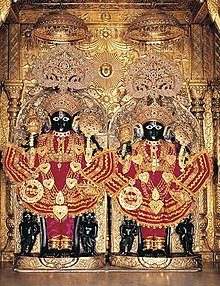دوقلوهای الهی


دوقلوهای الهی افسانکهایی در میان دین مردمان نیا هند و اروپایی بودهاست.
نمونه[ویرایش]
- دیوسکوری یونانی، کستور و پولوکس، پسران زئوس و لدا.
- اشوینهای هندو/ودیک، پسران سارانیو و سوریا.
- نارا-نارایانا هندو، این دو برادر آواتار خدای ویشنو در زمین بودند.
- آشویئنیای لیتوانیایی، که یک کالسکه از Saulė (خورشید) را از آسمان فرود آرند.
- دییوا دلی لاتویایی، پسران خدایان Auseklis (زهره) و Pērkons (تندر).[۱]
- پالیسی سیسیلی، یک افسانه ساخته شده که فرزندی از زئوس یا احتمالاً هفائستوس با آتنا یا ثالیا است. اما ادعای دیگری او را فرزند خدای سیسیلی Adranus میداند.
- خدایان آلسیس ژرمنی، یک جفت مرد جوان که برادرند و توسط Naharvali پرستش میشدند.
- رموس و رمولوس ایتالیایی، داستانی که اتفاقات منجر به تأسیس شهر رم و پادشاهی روم توسط رومولوس را بیان میکند.
- هنگیست و هورسا آنگلو-ساکسونی، گفت: از داستانهای آنگلها، ساکسونها و جوتها در قرن ۵ بریتانیا بود.
لادا و لادو اسلاو، زن و مردی تجسم یکدیگر که نشان از زیبایی و باروری بودند. گاه همسر و گاه مادر-فرزند دانسته شدهاند.
- تریز و زریز تَریز و زَریز بر پایهٔ مزدیسنا نام یک دیو از دیوهای کماله آفریده اهریمن میباشند. نام تریز همراه با زریر در ادبیات زرتشتی پیوسته با هم میآید. تریز دشمن خرداد و زریز دشمن امرداد میباشند.
در ناحیه یوروبا اریشا-ایبجی و در هائیتی Marassa Jumeaux نمونههای مشابهی هستند که در خارج از قلمرو فرهنگی هند و اروپایی رشد یافتند.
جستارهای وابسته[ویرایش]
پانویس[ویرایش]
- ↑ Vīķe-Freiberga, Vaira (2005). "Saule". In Jones, Lindsay (ed.). Encyclopedia of Religion. Vol. 12 (2nd ed.). Thomson Gale. pp. 8131–8135.
منابع[ویرایش]
- Steven O'Brien, Dioscuric Elements in Celtic and Germanic Mythology, JIES 10 (1982), 117-136.
- Michael Shapiro, Neglected Evidence of Dioscurism (Divine Twinning) in the Old Slavic Pantheon, JIES 10 (1982), 137-166.
- Donald Ward, The Divine Twins: An Indo-European Myth in Germanic Tradition (1968).
- Brian D. Joseph, “Old English Hengest as an Indo-European Twin Hero. ” The Mankind Quarterly 24 (1983), 105-115.
- Olga M. Davidson, “Aspects of Dioscurism in Iranian Kingship: The Case of Lohrasp and Goshtasp in the Shāhnāme of Ferdowsi,” Edebiyāt 1 (1987), 103-115.
- Gregory Nagy, “Patroklos, Concepts of Afterlife, and the Indic Triple Fire” and “Phaethon, Sappho’s Phaon, and the White Rock of Leukas: ‘Reading’ the Symbols of Greek Lyric,” in Greek Mythology and Poetics (1990).
- Douglas Frame, Hippota Nestor (2007).
- Douglas Frame, “Achilles and Patroclus as Indo-European Twins: Homer’s Take. ”
- Gregory Nagy, “Achilles and Patroklos as models for the twinning of identity."
